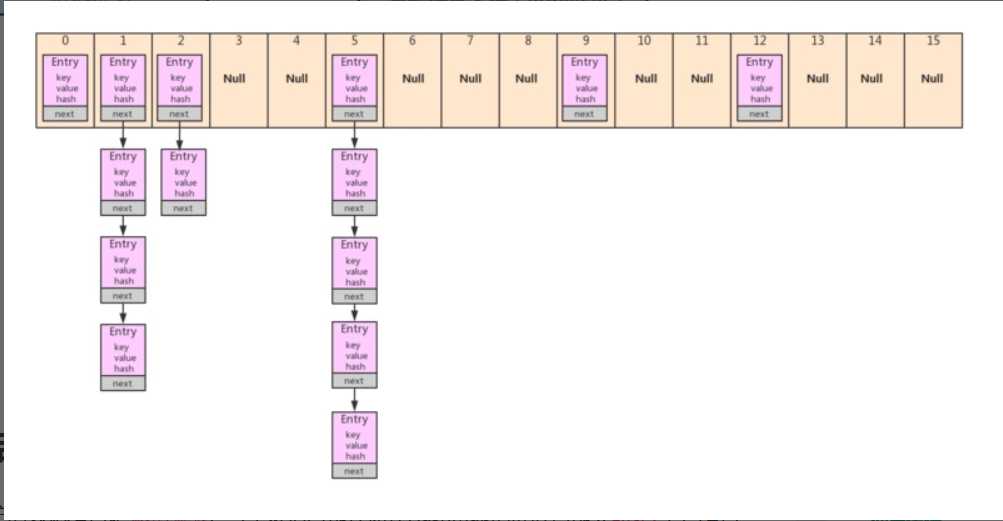标签:没有 cte 实现 rda func || 初始化 row 自己
HashMap很简单,原理一看散列表,实际数组+链表;Hash找索引.索引若为null,while下一个.Hash对对碰,链表依次查.加载因子.75,剩下无脑扩数组.


public class HashMap<K,V>
extends AbstractMap<K,V>
implements Map<K,V>, Cloneable, Serializable
static final int DEFAULT_INITIAL_CAPACITY = 1 << 4; // aka 16 默认初始化大小 10000B
static final int MAXIMUM_CAPACITY = 1 << 30; //最大的容量 2的20次方
static final float DEFAULT_LOAD_FACTOR = 0.75f; //影响因子 0.75 影响因子是哈希表在其容量自动增加之前可以达到多满的一种尺度。当哈希表中的条目 数超出了加载因子与当前容量的乘积时,通过调用 rehash 方法将容量翻倍。
static final Entry<?,?>[] EMPTY_TABLE = {};// 字面意思哈希表的入口数组.
static final int ALTERNATIVE_HASHING_THRESHOLD_DEFAULT = Integer.MAX_VALUE; //表示在对字符串键(即key为String类型)的HashMap应用备选哈希函数时HashMap的条目数量的默认阈值。备选哈希函数的使用可以减少由于对字符串键进行弱哈希码计算时的碰撞概率。
transient Entry<K,V>[] table = (Entry<K,V>[]) EMPTY_TABLE; //不可序列化的哈希表,初始化为上面空的哈希表
transient int size; //哈希表中存储的数据
int threshold; // 下次扩容的临界值,size>=threshold就会扩容
final float loadFactor; //影响因子
transient int modCount; //修改的次数
private static class Holder {...} //它的作用是在虚拟机启动后根据jdk.map.althashing.threshold和ALTERNATIVE_HASHING_THRESHOLD_DEFAULT初始化ALTERNATIVE_HASHING_THRESHOLD
transient int hashSeed = 0; //seed 种子值
public HashMap(int initialCapacity, float loadFactor){
this.loadFactor = loadFactor;
threshold = initialCapacity; //threshold 下次扩容的临界值也设置为 initialCapacity
init(); //一个空方法的实现
}
public HashMap(int initialCapacity){
this(initialCapacity, DEFAULT_LOAD_FACTOR);
}
public HashMap() {
this(DEFAULT_INITIAL_CAPACITY, DEFAULT_LOAD_FACTOR);
}
public HashMap(Map<? extends K, ? extends V> m) { //用Map初始化
this(Math.max((int) (m.size() / DEFAULT_LOAD_FACTOR) + 1,
DEFAULT_INITIAL_CAPACITY), DEFAULT_LOAD_FACTOR);
inflateTable(threshold);
putAllForCreate(m); //通过forEach,将复制到新的HashMap中
}
Math.max((int) (m.size() / DEFAULT_LOAD_FACTOR) + 1,
DEFAULT_INITIAL_CAPACITY) //保证了map构成新的HashMap的时候容量,计算Factor后小于对应的默认因子.
static class Entry<K,V> implements Map.Entry<K,V> {
final K key;
V value;
Entry<K,V> next; //一个典型的链表的实现.单向链表
int hash;
// 构造函数
Entry(int h, K k, V v, Entry<K,V> n) {
value = v;
next = n;
key = k;
hash = h;
}
//... 一些比较普遍方法的实现
//Entry中的自己的Hash的实现
public final int hashCode() {
return Objects.hashCode(getKey()) ^ Objects.hashCode(getValue());
}
}
final int hash(Object k) {
int h = hashSeed; //h为Hash的随机种子值
if (0 != h && k instanceof String) {
return sun.misc.Hashing.stringHash32((String) k);
} //生成对应字符串的哈希值
h ^= k.hashCode(); //hashCode之后异或
// This function ensures that hashCodes that differ only by
// constant multiples at each bit position have a bounded
// number of collisions (approximately 8 at default load factor).
h ^= (h >>> 20) ^ (h >>> 12); //最前面的12位和最后面的12位进行异或. 在与h异或,得到仍是一个32位的值
return h ^ (h >>> 7) ^ (h >>> 4);
}
/**
* Returns index for hash code h.
*/
static int indexFor(int h, int length) {
// assert Integer.bitCount(length) == 1 : "length must be a non-zero power of 2";
return h & (length-1); //对hash进行与运算,得到对应的存储的下标
}
public V get(Object key) {
if (key == null) //对应键为null的情况
return getForNullKey();
//普通的情况
Entry<K,V> entry = getEntry(key);
return null == entry ? null : entry.getValue();
}
这是一个私有方法,方便其他函数的调用
private V getForNullKey() {
if (size == 0) {
return null;
}
for (Entry<K,V> e = table[0]; e != null; e = e.next) {
if (e.key == null)
return e.value;
}
return null;
}
final Entry<K,V> getEntry(Object key) {
if (size == 0) {
return null;
}
int hash = (key == null) ? 0 : hash(key);
for (Entry<K,V> e = table[indexFor(hash, table.length)];
e != null;
e = e.next) {
Object k;
if (e.hash == hash &&
((k = e.key) == key || (key != null && key.equals(k))))
return e;
}
return null;
}
public V put(K key, V value) {
if (table == EMPTY_TABLE) {
inflateTable(threshold); //inflateTable方法就是建立哈希表,分配表内存空间的操作(inflate翻译为“膨胀”的意思,后面会详述)。但是指定初始容量和负载因子的构造方法并没有马上调用inflateTable。
}
if (key == null)
return putForNullKey(value);
int hash = hash(key);
int i = indexFor(hash, table.length);
for (Entry<K,V> e = table[i]; e != null; e = e.next) {
Object k;
if (e.hash == hash && ((k = e.key) == key || key.equals(k))) {//出现重复的值会覆盖
V oldValue = e.value;
e.value = value;
e.recordAccess(this);
return oldValue;
}
}
modCount++;
addEntry(hash, key, value, i);
return null;
void addEntry(int hash, K key, V value, int bucketIndex) {
if ((size >= threshold) && (null != table[bucketIndex])) {
resize(2 * table.length);// 容器当前存放的键值对数量是否达到了设定的扩容阈值,如果达到了就扩容2倍。扩容后重新计算哈希码,并根据新哈希码和新数组长度重新计算存储位置。做好潜质处理后,就调用createEntry新增一个Entry
hash = (null != key) ? hash(key) : 0;
bucketIndex = indexFor(hash, table.length);
}
createEntry(hash, key, value, bucketIndex);
}
void transfer(Entry[] newTable, boolean rehash) {
int newCapacity = newTable.length; //扩容后的处理
for (Entry<K,V> e : table) {
while(null != e) {
Entry<K,V> next = e.next;
if (rehash) {
e.hash = null == e.key ? 0 : hash(e.key);
}
int i = indexFor(e.hash, newCapacity);
e.next = newTable[i];
newTable[i] = e;
e = next; //链表成为了倒序
}
}
}
void createEntry(int hash, K key, V value, int bucketIndex) {
Entry<K,V> e = table[bucketIndex]; //入口
table[bucketIndex] = new Entry<>(hash, key, value, e); //让该节点替代入口地址,原来的链表连接在后面.就是所谓的头插法
size++;
}
链表的容量扩充为2的幂次. 调整 threshold 方法
private void inflateTable(int toSize) {
// Find a power of 2 >= toSize
int capacity = roundUpToPowerOf2(toSize); //实现了增长为2的幂运算. 实现也比较简单
threshold = (int) Math.min(capacity * loadFactor, MAXIMUM_CAPACITY + 1);
table = new Entry[capacity];
initHashSeedAsNeeded(capacity);
}
上面HashMap的基本操作已经完成了.下面就是一些对于Iterator接口的实现
private abstract class HashIterator<E> implements Iterator<E> {
Entry<K,V> next; // next entry to return
int expectedModCount; // For fast-fail
int index; // current slot
Entry<K,V> current; // current entry
}
Fail-Fast 机制
我们知道 java.util.HashMap 不是线程安全的,因此如果在使用迭代器的过程中有其他线程修改了map,那么将抛出ConcurrentModificationException,这就是所谓fail-fast策略。这一策略在源码中的实现是通过 modCount 域,modCount 顾名思义就是修改次数,对HashMap 内容的修改都将增加这个值,那么在迭代器初始化过程中会将这个值赋给迭代器的 expectedModCount。在迭代过程中,判断 modCount 跟 expectedModCount 是否相等,如果不相等就表示已经有其他线程修改了 Map:注意到 modCount 声明为 volatile,保证线程之间修改的可见性。
HashIterator() {
expectedModCount = modCount;
if (size > 0) { // advance to first entry
Entry[] t = table;
while (index < t.length && (next = t[index++]) == null)
; //在Hash计算的时候会有部分的表为空,找到一个不为空的值
}
}
public final boolean hasNext() {
return next != null; //第一次判断的是否不为空
}
final Entry<K,V> nextEntry() {
if (modCount != expectedModCount)
throw new ConcurrentModificationException();
Entry<K,V> e = next;
if (e == null)
throw new NoSuchElementException();
if ((next = e.next) == null) {
Entry[] t = table;
while (index < t.length && (next = t[index++]) == null)
; //同样利用循环找到写一个对应的链表节点
}
current = e;
return e;
}
假设线程A和线程B对一个共享的HashMap同时put一个值. put后发现需要扩容,扩容后进行内存拷贝执行transfer方法.那么必定出现循环链表.以后get() 的时候出现死循环.
理解HashMap 老哥写的比我好lt.com/a/1190000018520768) 老哥写的比我好
标签:没有 cte 实现 rda func || 初始化 row 自己
原文地址:https://www.cnblogs.com/king0/p/12899547.html